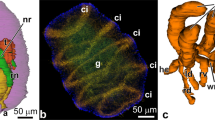Summary
-
1.
The general development of the mesonephros inBufo is similar to that ofRana (Gray, 1930) andRhacophorus (Reddy, 1938).
-
2.
Each malpighian unit arises from a nephroblast vesicle which is a condensation of 14 to 16 blastema cells.
-
3.
10 to 13 nephroblast vesicles are developed.
-
4.
The rudiment of the early peritoneal funnel appears as condensation of 4 to 6 blastema cells in front of the nephroblast vesicles.
-
5.
The condensation is simultaneous with that of the nephroblast vesicle.
-
6.
The rudiment develops after the perfection of the early malpighian capsule and establishes a connection between the cœlom and blood circulation.
-
7.
The early peritoneal funnels persist while early malpighian capsules with their tubules and glomeruli degenerate and disappear.
-
8.
The straight tubules and their outgrowths arise from 13 to 15 condensations on the dorsomedian wall of the archinephric duct.
-
9.
At the free end of the tubule is an abortive malpighian capsule.
-
10.
At the free end of each outgrowth or secondary tubule is a condensation of capsuloblast vesicle.
Similar content being viewed by others
Abbreviations
- A.D.:
-
Archinephric duct
- A.M.C.:
-
Abortive malpighian capsule
- B.:
-
Blastema
- B.V.:
-
Blood vessel
- C.F.N.:
-
Point at which the peritoneal funnel is constricted off
- D.G.:
-
Degenerating malpighian glomerules
- E.C.:
-
Capsule of the early malpighian unit in which the glomerulus has completely disappeared
- E.M.C.:
-
Early malpighian capsule
- F.N.:
-
Peritoneal funnel
- F.N. 1 &F.N. 2 :
-
Peritoneal funnels produced from funnel-forming tubule
- F.N.T.:
-
Funnel-forming tubule
- G.:
-
Glomerulus
- I.N.:
-
Opening of the peritoneal funnel into the blood vessel
- M.C.,1 M.C. 2 &M.C. 3 :
-
Later malpighian capsules developed from capsuloblast vesicles
- O.N.:
-
Opening of the peritoneal funnel into the cœlom
- O.St. 1 &O.St. 2 :
-
Outgrowths of the straight tubule
- P.W.:
-
Peritoneal wall
- R.F.N.:
-
Rudiment of the peritoneal funnel
- R.F.N.T.:
-
Rudiment of the funnel-forming tubule
- R.M.C.:
-
Rudiment of the early malpighian glomerulus
- R.St.:
-
Rudiment of the straight tubule
- St.:
-
Straight tubule
- T.:
-
Tubules
References
Bensley and Steen “The Functions of the Differentiated Segments of the Uriniferous Tubule,”Amer. Jour. Anat., 1928,41.
Bowman “On the Structure and Use of the Malpighian Bodies in the Kidneys with Observations on the Structure of that Gland,”Phil. Trans. Roy. Soc. Lond.,1842.
Buchanan and Fraser “The Development of the Urinogenital System in Marsupials, Part I,”Jour. Anat. Lond., 1919,53.
Clarke “The Early Development of the Wolffian Body inAmblystoma punctata,”Studies from the Biological Laboratory of Johns Hopkins University, 1881,2.
Farrington “The Nephrostomes ofRana,”Transactions of the Connecticut Academy of Science, 1892,8.
Filatow “Entwicklungsgeschichte des Excretionsystems der Amphibien,”Bulletin de la Societe des Naturelistes de Moscou, 1904,18.
FurbingerZur Entwickelung der Amphibienniere, Heidelberg,1877.
GoodrichThe Structure and Development of Vertebrates, London, 1930.
Gray “The Development of the Amphibian Kidney—Part I. The Development of theMesonephros ofRana temporaria,”Quart. Jour. Micr. Sci., 1930,73.
- “The Development of the Amphibian Kidney—Part II. The Development of the Kidney ofTriton vulgaris and a comparison of this withRana temporaria,”ibid., 1932,75.
- “The Development of the Amphibian Kidney—Part III. The Post Metamorphic Development of the Kidney and the Development of the Vasa Efferentia and Seminal Vesicles inRana temporaria,”ibid., 1936,78.
Hall “The Development of the Mesonephros and Mullerian Ducts in Amphibia,”Bull. Mus. Comp. Zoo. Harvard, 1904,44.
Hirt “Zur Innervation der Niere und Nebenniere des Frosches,”Zeit. f. Anat. u. Entw., 1930,91.
Hoffmann “Zur Entwickelungsgeschichte der urinogenitalorgane bei den Anamnia,”Zeitschrift fur wissenschaftliche Zoologie, 1886 ,44.
KerrText-Book of Embryology, “Vertebrata,” London, 1919,2.
Marshall “The Aglomerular Kidney of the Toadfish (Opsanus tau),”Bull. Johns Hopkins Hosp., 1929,45.
- and Bles “The Development of the Kidneys and Fat Bodies in the Frog,”Studies from the Biological Laboratory of Owens College, 1890,2.
- and Grafflin “The Structure and Function of the Kidney ofLophius piscatorius,”Bull. Johns Hopkins Hosp., 1928,43.
- and Smith “The Glomerular Development of Vertebrate Kidneys in Relation to Habitat,”Biol. Bul., 1930,59.
Nash “The Number and Size of the Glomeruli in the Kidneys of Fish, with Observations on the Morphology of the Renal tubules in Fishes,”Amer. Jour. Anat., 1931,47.
Nussbaum “Endigung der Wimpertrichter i.d. Niere der Anura,”Zoologischer Anzeiger, 1880,3.
Reddy “The Development of Anuran Kidney—Part I. The Development of the Mesonephros ofRhacophorus maculatus,”Proc. Ind. Acad. Sci., (B), 1938,8, No. 4.
Spengel “Das Urinogenital system der Amphibia,”Arbeiten vom Zoologischen Institut der Universitat Wurttemberg, 1876,3.
Wheeler “The Development of the Urinogenital organs of the Lamprey,”Zool. Jahrb;Abt. f. Anat., 1899,13.
Author information
Authors and Affiliations
Additional information
Communicated by Prof. S. G. M. Ramanujam,m.a. ph.d., d.i.c., f.z.s.
Rights and permissions
About this article
Cite this article
Reddy, A.R. The development of Anuran kidney. Proc. Indian Acad. Sci. 8, 413–426 (1938). https://doi.org/10.1007/BF03048484
Received:
Issue Date:
DOI: https://doi.org/10.1007/BF03048484




